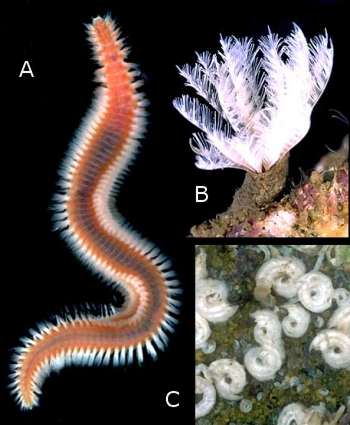
Polychaete Worms (Bristle worms)
Polychaete worms are closely related to leeches and earthworms and together make up the Phylum ANNELIDA. Polychaetes are often called bristleworms because each of the body segments has an upper and lower bundle of bristles (called setae or chaetae) on each side. In free-living polychaetes, the bristles, combined with snake-like body waves, help the worm to move along. In Fireworms, Eurythoe spp (A), the bristles have evolved into defensive organs. They are fragile, hollow tubes filled with poison. They are easily broken when the worm is touched and the pain they cause when they pierce the skin makes their common name very appropriate.
The bristles found in worms that live in tubes or burrows (sessile or sedentary worms) have often evolved into hooks to help anchor the worm in place. Sedentary worms make a whole variety of homes. Many make a hard calcareous tube (C - Spirorbis), which is attached to a hard surface or even large algae. Other sedentary worms have a leathery tube, sometimes decorated with pieces of broken shell, or sand and mud particles.
Free-living worms include carnivores, herbivores and scavengers. Some, such as the fireworms, are active carnivores feeding on colonial animals eg: sponges and ascidians). On the other hand, sedentary worms, (which cannot move about), usually feed on microscopic plants and animals or fine particles. Many sedentary worms filter plankton out of the water by a crown of feathery tentacles that surround their mouth and give them their common name of 'fanworm' or 'feather duster' worm (B).
Worm is a common name which applies to a 'shape' rather than a particular phylum or class of animals, much as 'slug' applies to much more than opisthorbanch molluscs. There are a few slug-like worms, such as Aphrodite which are sometimes mistaken for sea slugs.
Authorship detailsRudman, W.B., 2004 (July 27) Polychaete Worms (Bristle worms). [In] Sea Slug Forum. Australian Museum, Sydney. Available from http://www.seaslugforum.net/factsheet/polychaete
Related messages
-
Re: Sea Mouse from South Australia
From: Duncan Gunstone, November 2, 2007 -
Re: Sea Mouse from South Australia
From: Judith Jones, July 23, 2007 -
Sea Mouse from South Australia
From: Judith Jones, July 20, 2007 -
Purple Snake-thing from Alaska
From: Melissa Brook Steward, July 9, 2007 -
Sting on my finger from Florida
From: Jason Horn, July 2, 2007 -
Re: Today's mystery guest from Sulawesi
From: Leslie Harris, June 22, 2007 -
Today's mystery guest from Sulawesi
From: Ken Tucker, June 5, 2007 -
Re: Giant nudibranch? off Vancouver Island, Canada
From: Leslie Harris, August 5, 2006 -
Giant nudibranch? off Vancouver Island, Canada
From: Don Belke, August 4, 2006 -
Re: 'Sea Mouse' from England
From: Sally Elizabeth Moore, January 14, 2006 -
'Sea Mouse' from England
From: Sally Elizabeth Moore, January 13, 2006 -
Nudibranch ? from North Carolina
From: Robert Todd, July 4, 2005 -
Sea Mouse from Lancashire?
From: David Hulston, May 28, 2003 -
Re: Spiny mystery from Ireland
From: Cian Murphy, January 9, 2003 -
Spiny mystery from Ireland
From: Cian Murphy, December 23, 2002 -
Re: hairy worm from Brisbane
From: Chris Glasby, June 5, 2002 -
Re: Hairy 'worm' from Brisbane
From: Kerri, June 5, 2002 -
Re: Hairy 'worm' from Brisbane
From: Clinton Bauder, June 5, 2002 -
Hairy 'worm' from Brisbane
From: Kerri, June 2, 2002
